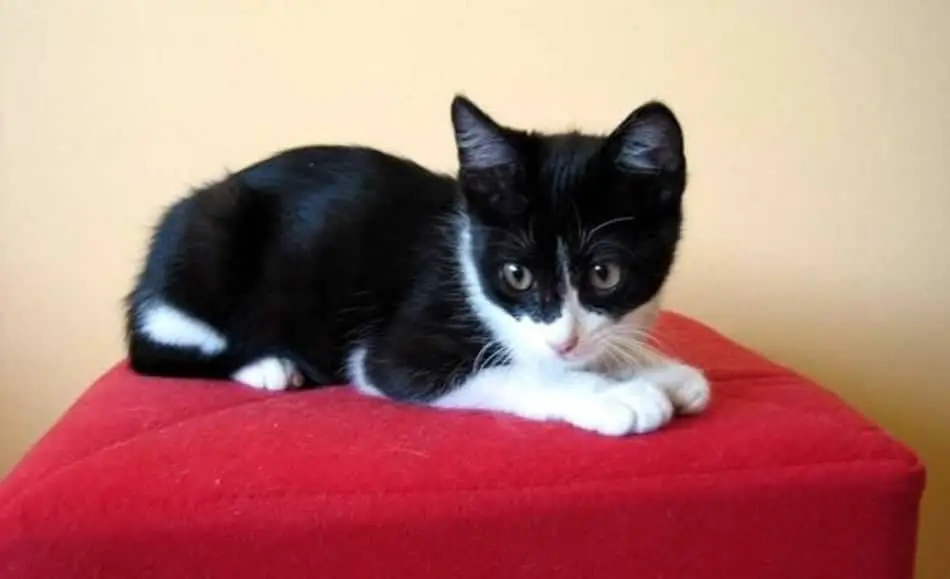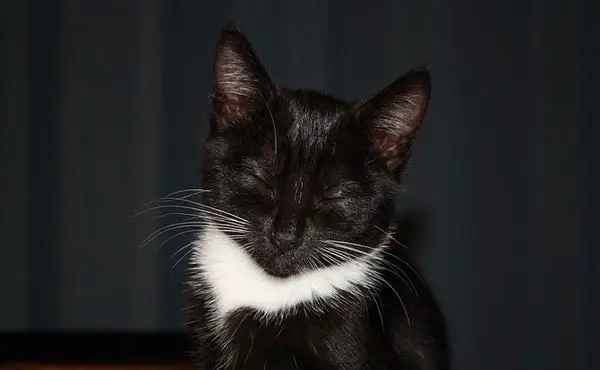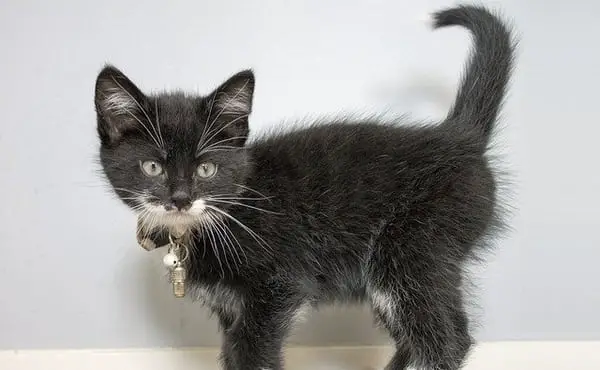Wondering why your kitten is getting white hairs? The most likely reason is because your kitten’s fur is undergoing natural pattern changes common in cats, largely due to its genetics. There could also be an underlying medical condition at play, a phenomenon called fever coat, or even stress.
Bringing home a kitten is always an experience full of surprises—their budding personalities, quirks, all the mischief they get into. Sometimes, kittens will even surprise us by changing color! Most of the time, however, this special trick is no cause for concern.
This article will examine how your kitten’s coat color genes express themselves and will discuss some medical conditions that could cause the white hairs. Additionally, the article will cover a phenomenon called “fever coat,” and the effects of stress.
Article highlights
- Your kitten’s whiskers changing color is likely nothing to be worried about
- Whiskers can change color because of normal growth due to genes
- In some rare cases it can be due to a medical condition
Dominant Genes
From snow leopards and wild cats in the highest mountain ranges to jungle cats and lions prowling the savannah; from feral cat colonies braving a concrete jungle to domestic cats living the good, air-conditioned life—the range and assortment of colors and patterns of cats everywhere is mind-blowing.
Stripes, spots, mottled, calico, sleek black, pure white, and everything imaginable in-between, cats from all walks of life and from the time our housebound companions were first domesticated, the fantastical array of color has been one of the things (among many) that draws us to these felines.
Thanks to the complexity of cat coat genetics (color, pattern, texture, and length, just to begin with), coupled with the mystery of most domestic cats’ breeding history, knowing the final color and pattern of your kitten’s coat is next to impossible.
Unless you purchased a generationally pedigreed cat from a breeder, chances are you do not know what genes have been thrown into the mix that resulted in your fluffy ball of joy, and that is okay!
Why is My Black Kitten Getting White Hairs?
So, if your black or dark-colored kitten is sprouting a few white hairs here and there, it is no cause for concern—it likely is just your kitten’s genes figuring out the finished product that is your new pal.
Without getting too technical, your cat may have what is commonly referred to as the white spotting gene, a dominant gene resulting in coloration between 0 and 50 percent white. Due to the dominant nature of this gene, only one variation is necessary for the trait to be expressed, leading to the appearance of a black kitten with white hairs.
One common example of the white spotting gene expressing itself in cats is the loveable “tuxedo” pattern. The tuxedo pattern can be expressed in multiple breeds and is distinguishable because it looks like the human formal wear for which it is named.
Tuxedo cats have all-black genes and the white spotting gene, resulting in a large spectrum of color variation, from a tiny chest patch to the whole enchilada complete with socks and a dashing moustache.
Even if your kitten or either of its parents do not display the full “tuxedo” pattern, the white spotting gene may be present somewhere in the kitten’s lineage, along with other complicated genes that only express under certain circumstances. This is how your silver tabby and black tom cat can produce a litter of striped, orange, black, or calico kittens.
Genetics! Because the gene can express anywhere from no white to half-white, your kitten may only have a smattering of white hairs, or eventually develop full patches. In any case, this gene expression is absolutely no cause for concern, and likely will simply be a fun waiting game for you to see how your kitten grows and changes.
Aside from a genetic predisposition to fun color-changing coat tricks, there could be an underlying medical condition prompting your kitten’s new look.
It could be a medical condition
Cats and kittens are thought to be among the most straightforward domestic animals for which to care—give them food, water, toys, and a place to sleep, and they should be fine, right? For the most part, yes, although cats do benefit greatly from affection and time spent with each other and with us humans, despite their relentlessly aloof reputations.
For healthy cats, this seems easy. Sometimes, however, through no fault of our own, our feline friends can become ill, so it is up to us to understand what these illnesses look like and what they mean.
Vitiligo
If you notice white hairs on your black kitten, it’s essential to consider the possibility of vitiligo, a progressive depigmentation condition that can affect both the skin and coat color over time.
It usually begins with the face but could spread across the entire body. Vitiligo may result in patches of white on one area like the snout or in various patterns across the body, the most common of which are referred to as “cobweb” or “snowflake” patterns.
Typically, vitiligo is nothing to worry about, as it is painless and will cause no discomfort for your pet. It is wise, however, to try to determine any underlying causes there may be, as vitiligo can sometimes be caused by stress, exposure to toxins, and even neurologic disease.
Consult your veterinarian if you suspect there may be more to your kitten’s case of color changing.
Another possible cause of vitiligo, or potential driver behind depigmentation in general, are autoimmune diseases. Fortunately, these are rare in cats, however, there is one immune disorder called discoid lupus erythematosus (DLE) that could be causing your kitten’s hair to blanch.
Autoimmune diseases cause the immune system to attack itself by mistake, causing serious illness and/or complications from other illnesses. DLE is rare but does produce depigmentation around the face, ears, and genitals of cats. Fortunately, if you schedule a visit with your veterinarian, they can diagnose and treat your pal with minimal trouble.
Other medical conditions and symptoms
One final potential medical cause for depigmentation is liver or kidney disease. This symptom is somewhat rare for these disorders, but it does occur because these filtering organs, when afflicted, cannot filter out toxins quickly enough, resulting in color change.
Here are some other, more common symptoms, to look for if you suspect your kitten may be suffering from liver or kidney disease:
- Excessive thirst
- Decreased appetite
- Increased urination
- Weight loss
- Dull or disheveled coat
- Vomiting or diarrhea
- Jaundice (yellowing skin and whites of eyes)
As with any medical condition, if you suspect liver or kidney disease, consult your veterinarian right away as these conditions can be serious. However, if caught and treated, not only will your kitten resume its daily cuteness, but the depigmentation may reverse as well.
If you have ruled out genetics and medical conditions, your kitten’s fantastical color-changing skills could be contributed to something called “fever coat.”
Fever Coat
If you have not heard enough about color-changing kittens yet, read on because the phenomenon known as fever coat is another amazing example of this funky feline trick. Fever coat, also known as stress coat, occurs when kittens are born to a mother who was exposed to a fever-inducing infection or extreme stress during their pregnancy.
These conditions result in an above-average temperature within the womb that produces unusual coloration in the kittens’ coats, ranging from white or cream, to reddish, and even silver. These colors occur because the high heat prevents pigments from properly depositing into the fur.
Fever coat can result in all-over color or in patches of color throughout the kitten’s body. Some kittens may exhibit different patterns mixed with their true colors. For example, some kittens may have an all-over fever coat, while others have a fever-coated body with true-colored legs, face, and tail.
Others may sport patches, tortoise stripes, frosted tips, or a dorsal stripe resulting in close resemblance to a skunk! The combinations of color patterns for fever coats in kittens are, as you have probably guessed, practically endless.
The fever coat is usually short-lived, lasting only about four to eight months, and gradually fades back into the true-colored coat your kitten is destined to display.” A fever coat may indicate that mama was sick or stressed, but most kittens with the condition are healthy, so there is no need to fret. Enjoy your magical color-changing kitten while you can!
If you have read this far and nothing fits your feline’s follicular affliction, stress could be the answer.
Stress
Although cats are predatory by nature and enjoy a (only partially earned) reputation for being aloof and standoffish, they actually do not handle stress very well. There are not as many things that may cause stress to cats as there are to other domestic animals like rabbits or rodents, but when cats become stressed it usually results in dramatic effects.
Common stressors for cats are often new things—new pets, new babies, new furniture, new homes. For your kitten, the recent move from its birthplace, mother, and littermates to a new home with no familiar faces, scents, or sounds, could be enough stress to cause them to go gray!
If you suspect stress is the culprit, look for other signals like excessive vocalization, bladder or digestive issues, uncharacteristic aggression, or excessive grooming.
You can help alleviate your kitten’s stress by placing them in a smaller space with their own things for a while and making sure they feel welcome and loved in their new home by offering treats, play, and affection.
In a multi-cat household, make sure each cat has their own belongings (toys, bed, bowls, etc.) and let them eat separately, but within eyeshot, of each other. With time and patience your kitten’s stress will melt away, and the depigmentation may even go away as well.
Summary
If your black or dark-colored kitten has suddenly sprouted white hairs, it most likely is because of natural fur pattern changes driven by your pal’s genetics. Cat coat genetics are complicated but will not affect your kitten negatively in any way, so no need to worry.
Barring genes, your cat may be experiencing a medical condition such as vitiligo or an autoimmune disease. Vitiligo is usually harmless but schedule a visit with your vet just in case, as sometimes there are other underlying causes.
Your little bundle of joy could have been born to an ill or anxious mama, resulting in a fever coat, which is harmless and temporary so again, fear not! Finally, your feline friend may be experiencing some stress, so make sure they feel safe and welcome in your home and in time they will be happy as a clam.
In most cases, your kitten’s magical color-changing ways likely are no cause for concern, so if you are vigilant about their health and well-being, sit back and enjoy the show as your kitten grows and changes with you.





